Вроде как в интервью мелькнула тема сравнения старой и новой версии флагманской модели. Так вспомнился обзор на Hodinkee...
Сорри если уже цитировался, но уж больно толковый )))
The Original Lange 1 Compared To The New Version For 2015
The Lange 1 is a watch that isn’t just iconic, it’s a watch that is so iconic that saying so is one of the biggest clichés in watch journalism. Cliché it may be, but it is actually true – though interestingly enough, when the Lange 1 first debuted, it was considered a very innovative and even controversial design. It’s a testimony to just how effectively A. Lange & Söhne, all the way back in 1994, hit the sweet spot for enthusiasts in terms of combining traditional Saxon watchmaking design cues with a fresh approach to dial composition, that the Lange 1 has in the subsequent decades become one of the most recognizable, and also the most imitated, watches in the world.
One alters an icon at one’s own peril, however for 2015, A. Lange & Söhne did just that: the firm introduced a new version of the Lange 1 (hard on the heels of the previous years’ update to the Datograph, another one of their most beloved models). The new version of the Lange 1 is cosmetically almost identical to the original, and put side by side you would be hard pressed to tell one from the other – according to Lange the only difference topside is that the new version has a slightly narrower bezel than the original. This is not to say that there is not an effect on the aesthetics of the watch, however – the original version gives an ever-so-slightly greater visual impression of mass and in a very subtle way, this contributes to the feeling of stolidly Germanic and slightly anachronistic charm that was much of the personality of the company as a whole when its first collections debuted. The newer version, on the other hand, seems a bit more airy (to the extent that a Lange 1 is airy, of course) and with the bezel framing the dial less emphatically one now feels, as with a picture in a more modern frame, that one can see the composition somewhat more clearly. Both work, in their own way; which you prefer depends on whether you like a gilt-bordered Old Master or something ever so slightly more contemporary.
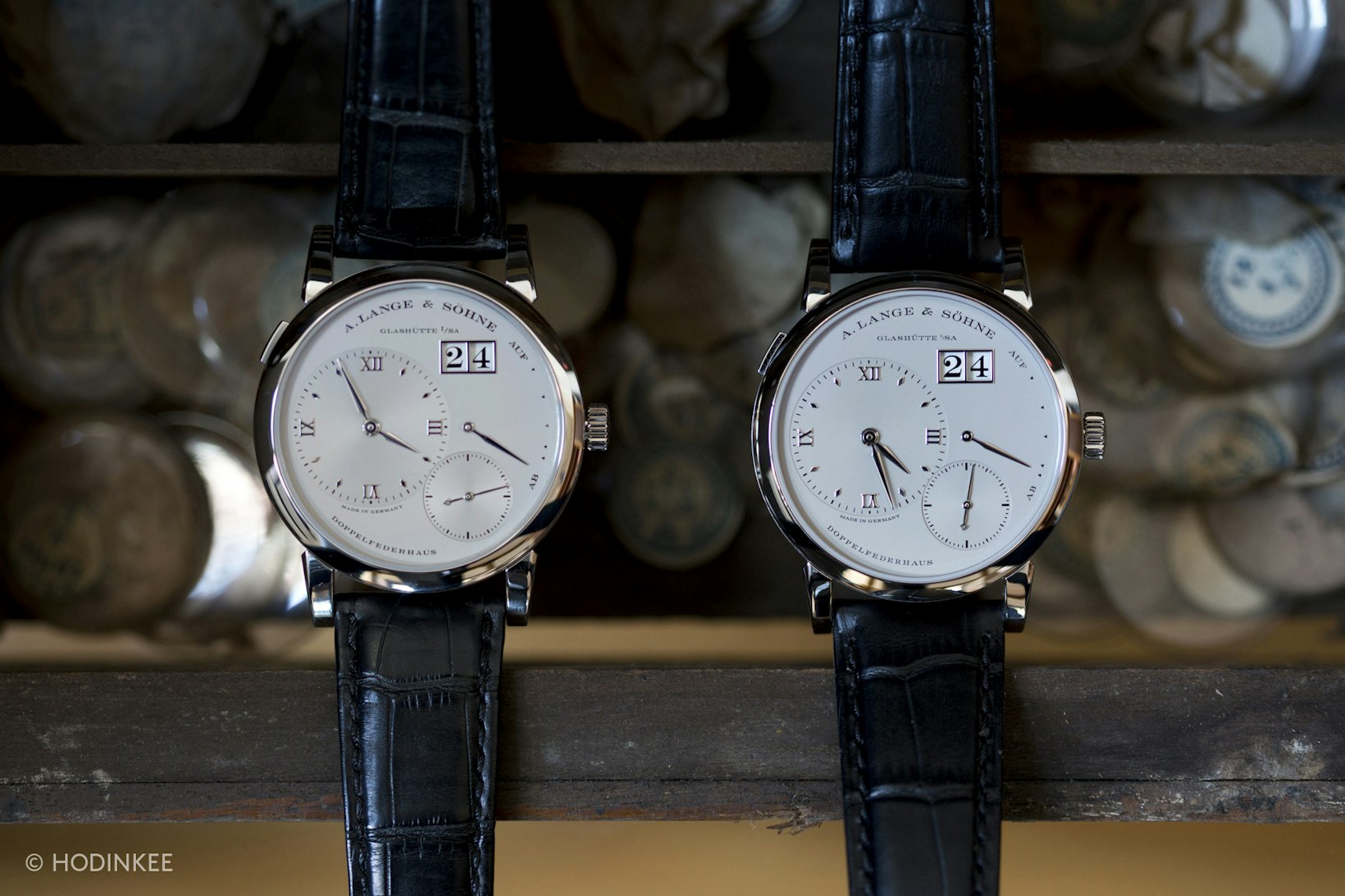
слева - старая модель, справа - новая
Edge on, there is also little to distinguish the old from the new; thickness, diameter, curvature and length of the horns, finish – all are unchanged from the original to the new. However it’s a different story when you turn the two watches over and compare the movements. Our first hint that these are not identical mechanically comes when we look at the dimensions – those of the movement in the original Lange 1, the L901.0, are 30.4 mm x 5.9 mm, while those of the new version, the caliber L121.1, are 30.6 mm x 5.7 mm.
The level and style of finishing are identical in both, which is to say, at a very high level. The Lange 1 in both incarnations uses a three-quarter-plate construction, in which all the train wheel pivots, as well as those for the two mainspring barrels and also, the pivots for wheels for some of the displays, have to be placed. The only visible components separate from the mainplate are the balance, balance spring, lever, and escape wheel; the balance and escape wheel are under their own cocks and the lever has its own bridge.
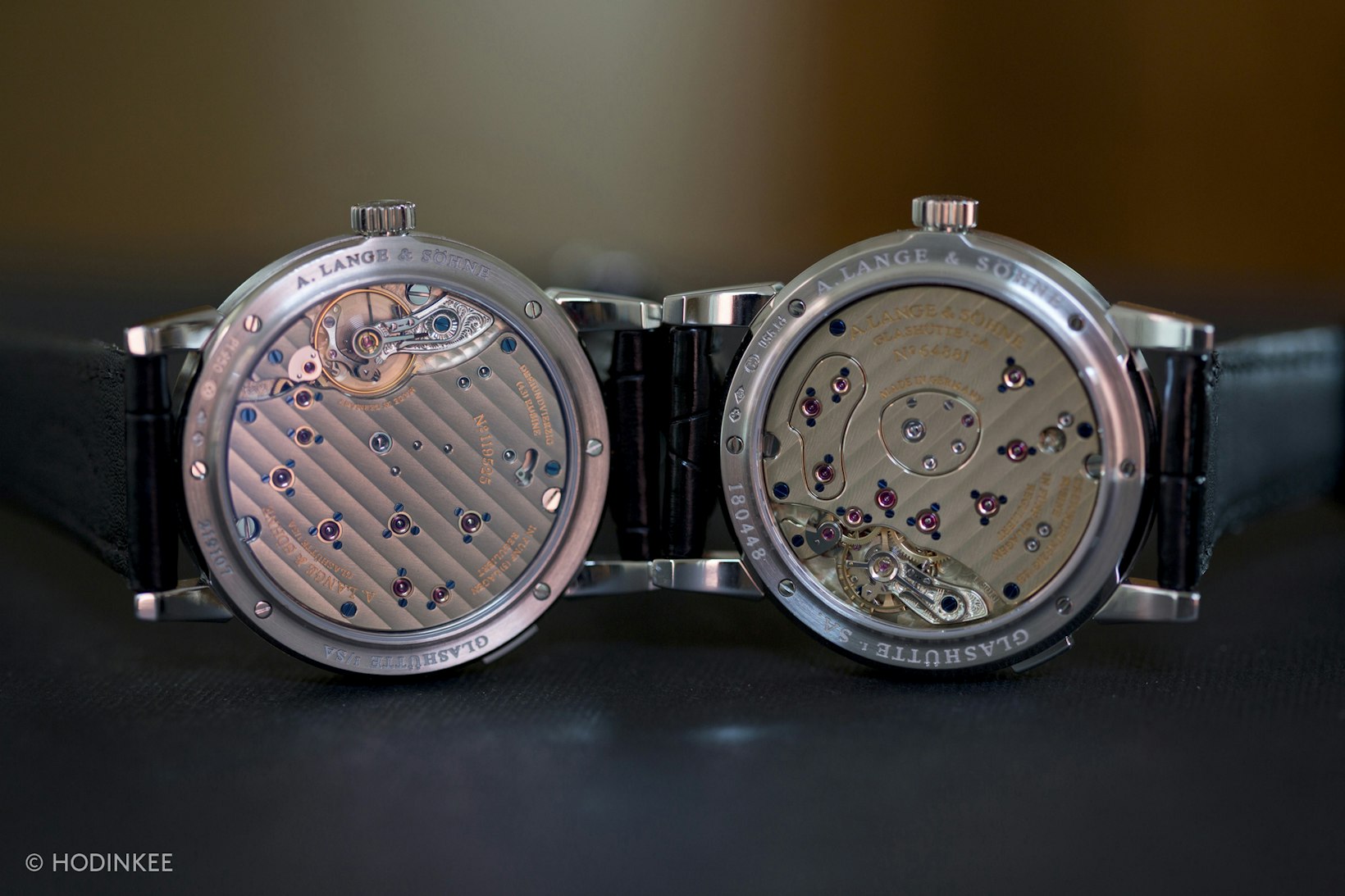
слева - новая, справа - старая
The first major difference you might notice is in the balance. The original Lange 1 uses a balance with screws mounted on the balance rim and as well, the balance spring’s effective length can be altered with a regulator. A regulator consists of two pins, attached to an adjustable sweep; the balance spring passes between the pins and you can change its effective length by moving the sweep. This allows a watchmaker to control the rate of the watch – to make it run faster or slower.
It’s an effective solution but the new version uses one that is very typical of high quality, chronometer grade watches: the balance is free-sprung, which is to say, there is no regulator. Instead, the rate of the balance is controlled by eccentric weights on the rim, which control its effective diameter. There are several theoretical advantages to this arrangement, although final results in both cases depend on the skill of the watchmaker (of course). In the new version of the Lange 1, what looks like a swan’s neck regulator is actually a (visually almost identical) mechanism for adjusting the position of the stud, which is the attachment point for the outermost coil of the balance spring.
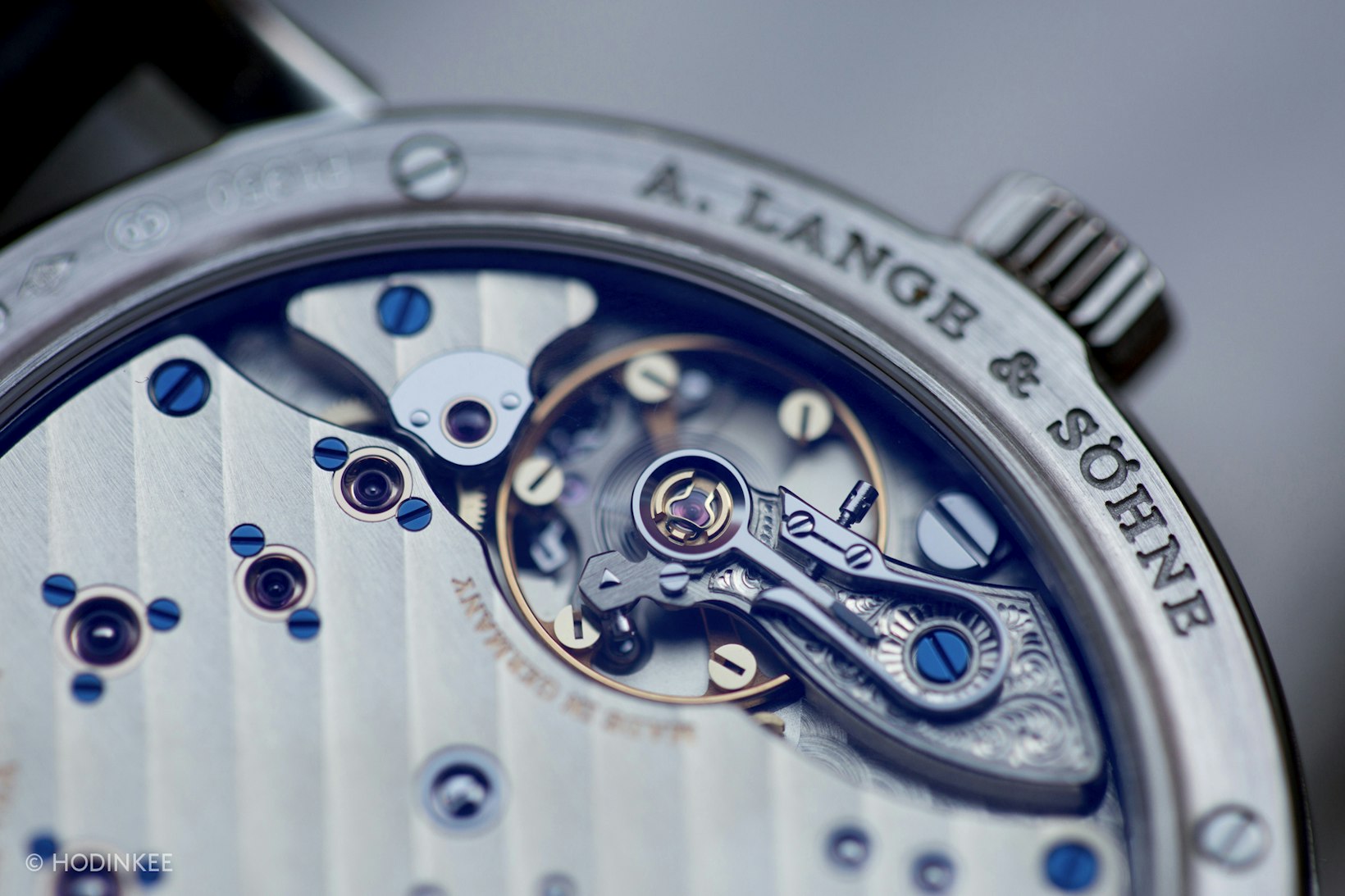
Новая модель
If you compare the two movements side by side you will also notice some considerable differences in the layout of the gear trains, and this is actually one of the most interesting points in understanding how the Lange 1 continues to evolve. To understand what we’re looking at, let’s look first at a typical movement layout. This diagram shows the arrangement of wheels in a classic pocket watch movement.

Standard gear train in a watch movement; L-R, mainspring barrel, center wheel, third wheel, fourth wheel, escape wheel, lever (balance not shown)
Starting from the mainspring barrel (in the diagram, on the left, and moving from left to right) we have the center wheel, third wheel, fourth wheel, escape wheel (with its distinctive asymmetrical teeth) the lever, and finally the balance and its spring. Two things to bear in mind: the center wheel drives the hands of a watch and is centered right below them, and the fourth wheel, in a typical movement, turns once per minute. That means that if you want a seconds hand, all you have to do is stick a hand on the fourth wheel pivot, and you’re good to go. The fact that in a classic gear train, the fourth wheel is off to one side, is the reason that in, say, a vintage pocket watch, you’ll see the seconds in a subdial (and it’s also the reason that for much of watchmaking, center seconds hands were considered a complication, but that’s another article).

Now, let’s look at the Lange 1, but before we do that, we have to keep in mind one key point: the arrangement of the gear train is different than that of a classic movement, because the displays are arranged differently than in a classic movement. Lange had a dial design they liked but to make it work, they had to rearrange the entire gear train. With that in mind, let’s look at the original Lange 1. If you don't already know this, now's a good time to mention that the jewels in the mainplate are bearings for gear pivots --so every time you see a jewel, just remember there's a gear/wheel underneath it.
First of all, let’s start counting backwards from the balance. There under its cock is the escape wheel, then (moving roughly counter-clockwise in the above image) there is the fourth wheel, third wheel, and center wheel. The first thing you will notice is that the center wheel is not actually in the center of the movement – it is off to one side, and why this is so is instantly understandable when you realize that the subdial for telling the time is off center on the dial side, and the center wheel is actually right under the time subdial. This also explains what the ovoid “island” in the center of the watch really is – it’s actually the cover for the keyless works, which is what watchmakers call the mechanism for winding and setting. The stem runs all the way from the winding crown to the center of the movement.
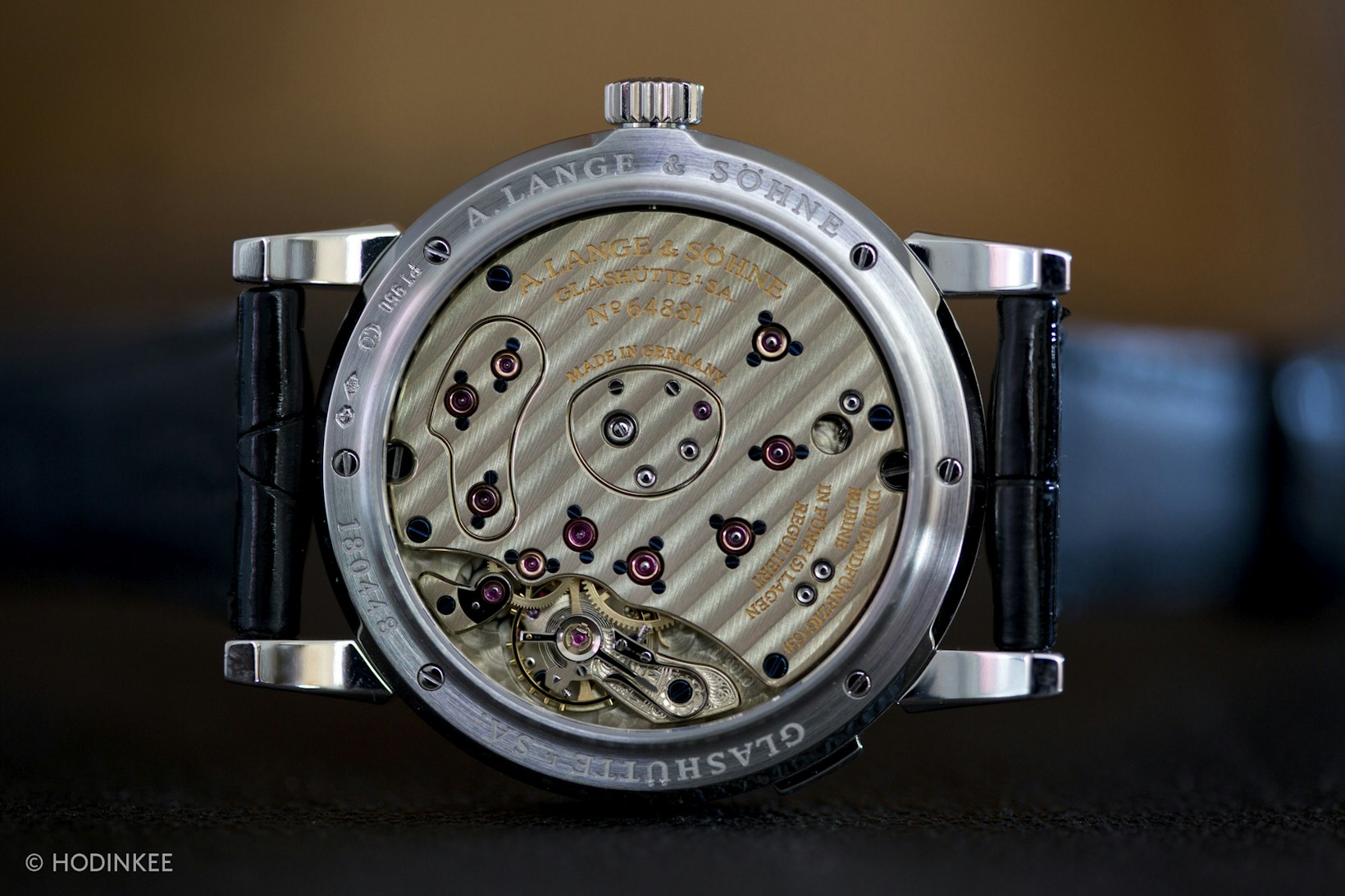
Now if you continue to count backwards, from the center wheel you next reach the first mainspring barrel. Remember, however, that on the dial it says “doppelfederhaus,” which is German for “double mainspring barrel.” The next chaton is for an intermediate gear connecting the first mainspring barrel to the second – and the last chaton is for the second mainspring barrel. And that accounts for almost all the visible jewels.
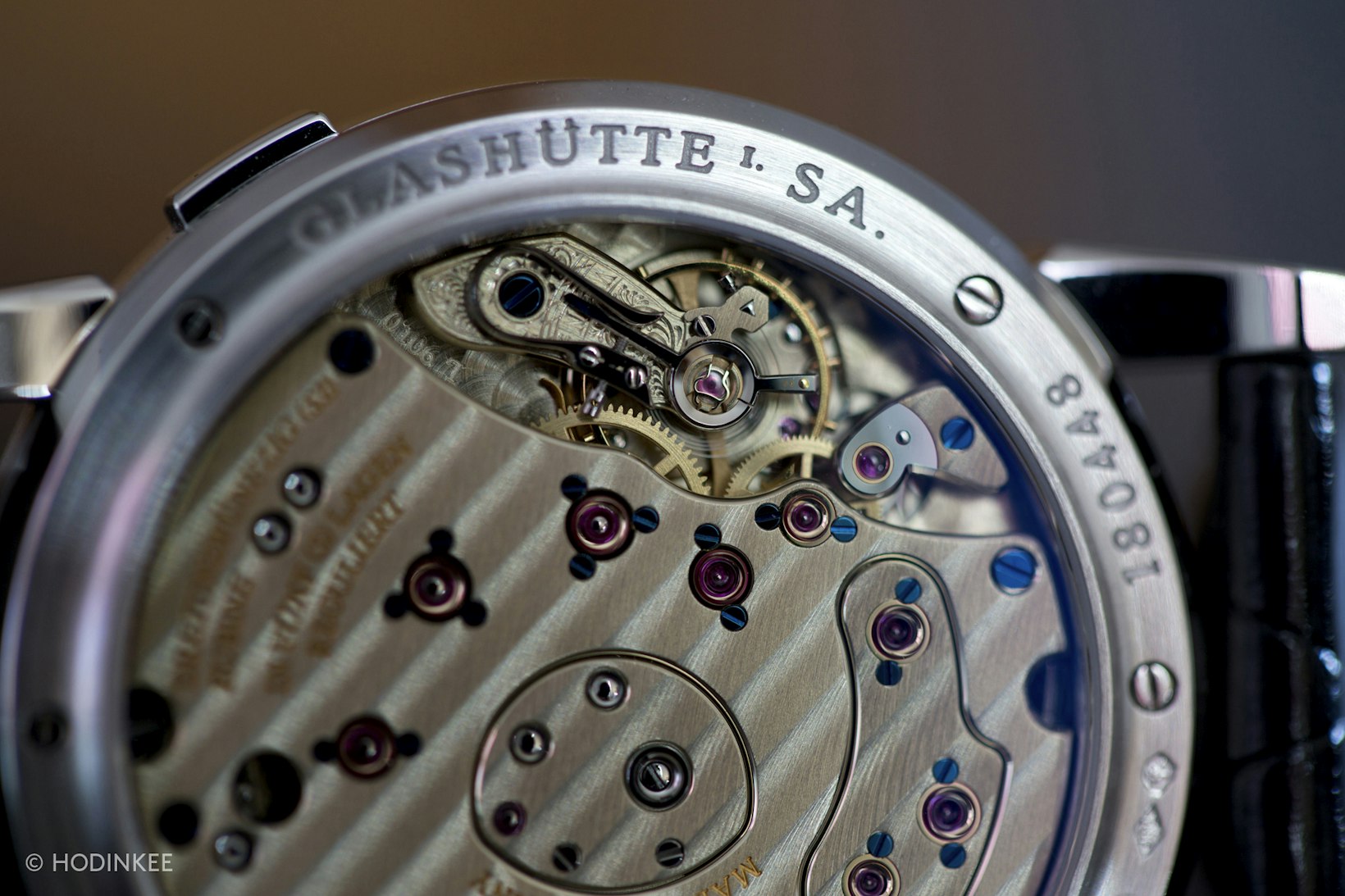
The only big mystery remaining, then, is what the heck the three pivots are that are located in that other “island” in the plate – the sort of cleaver shaped one at 6 o'clock. The answer to this mystery lies in looking at the location of the seconds subdial on the dial side. As you now understand, in this watch you can’t put the seconds hand on the fourth wheel pivot directly as that would put the seconds hand in the wrong place. So to get power to the seconds hand, Lange has used three additional gears to get power over to the other side of the dial where they wanted the sub-seconds dial to be – and that is what those three pivots are in that funny-shaped cut-out on the mainplate.
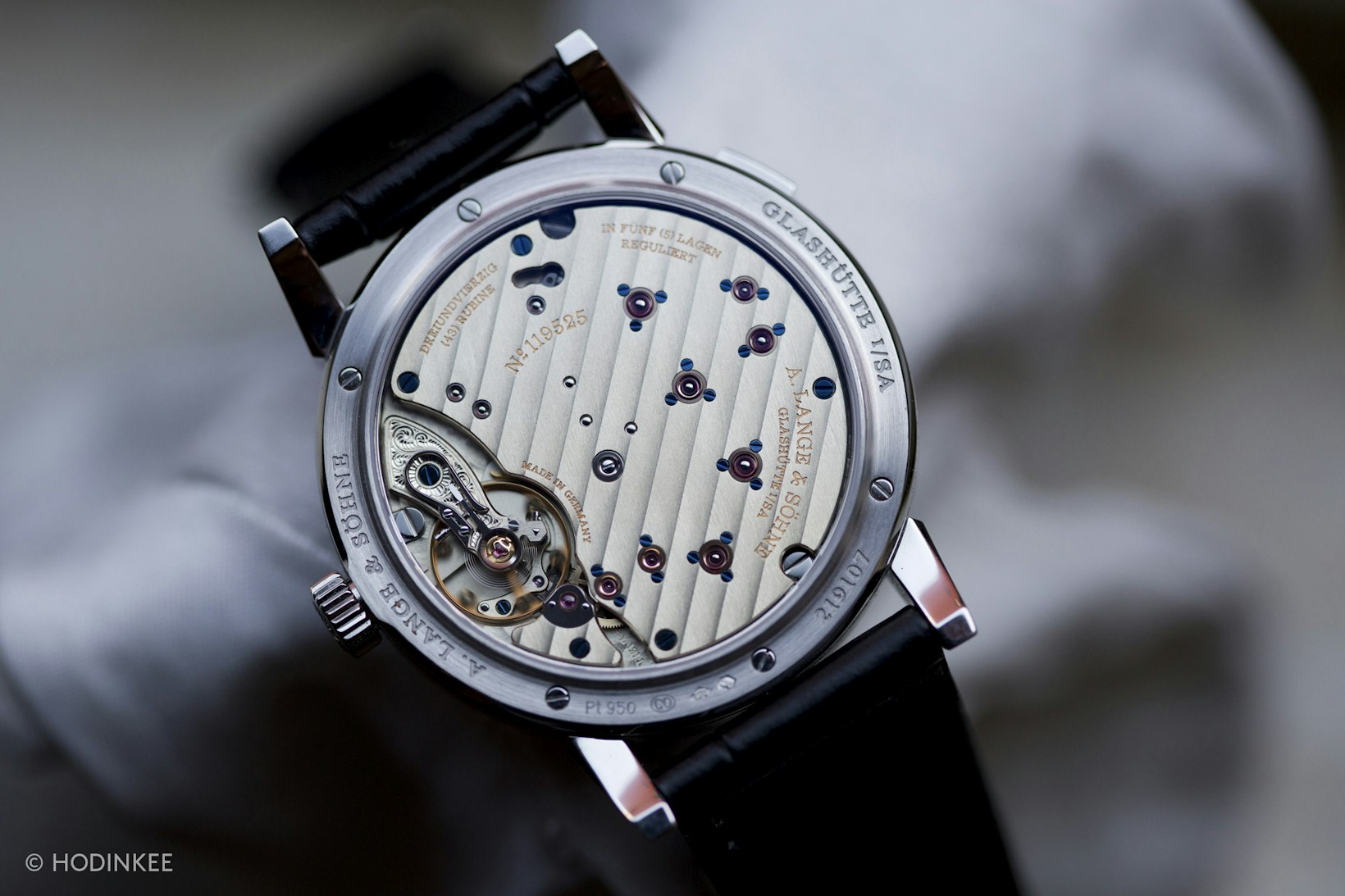
Now that we have unlocked the mysteries of the original Lange 1, it is easy to understand the new version. The first and most important distinction to note is that now the balance is actually right next to the crown, instead of on the opposite side of the movement from it. The most immediate result of this is that it allows for a much more logical placement of the main gear train wheels – most notably, in the new version the fourth wheel is now directly under the seconds sub-dial, and that means you don’t need those three extra gears – the seconds hand is driven directly. (Lange's technical director, Anthony De Haas, shared with us that designing the movement to incorporate directly driven seconds was a major priority in the design brief.) If you look closely you can also see that there is a little step in the mainplate under the balance wheel – that’s because the keyless works are still in the center of the movement and the stem now has to run directly under the balance to get there.

Counting backwards from the escape wheel (again, counterclockwise in the above image), we can easily count the pivots and jewels for the fourth wheel, third wheel, center wheel, first mainspring barrel, intermediate wheel, and second mainspring barrel. The only remaining mystery concerns the two jewels and their pivots hard up against the edge of the plate, right next to the first mainspring barrel. According to Anthony De Haas, these are actually the first two gears of the power reserve complication. The power reserve displays how much energy is left in the mainspring by counting the number of times the barrel has turned, but in the Lange 1 version 2, the power reserve indication is now on the other side of the dial from the mainspring barrel; those two jewels are for the pivots of the first two gears carrying that information to the power reserve display.
Finally, one other major and very important change from an owner’s perspective is that the big date display is now a quick-change display, switching over instantaneously at midnight.
It’s been a bit of a longer journey than we usually take on HODINKEE to get to our destination, but if you’ve gotten this far, you now know something really interesting about the evolution of one of the most distinctive watches on the planet – one whose design A. Lange & Söhne has changed most significantly, in the place where it counts the most – which is just the way we like to think the company’s biggest fans would want it.
Оригинальный материал здесь:
http://www.hodinkee.com/blog/compari...2015-new-model












 Похожие темы
Похожие темы